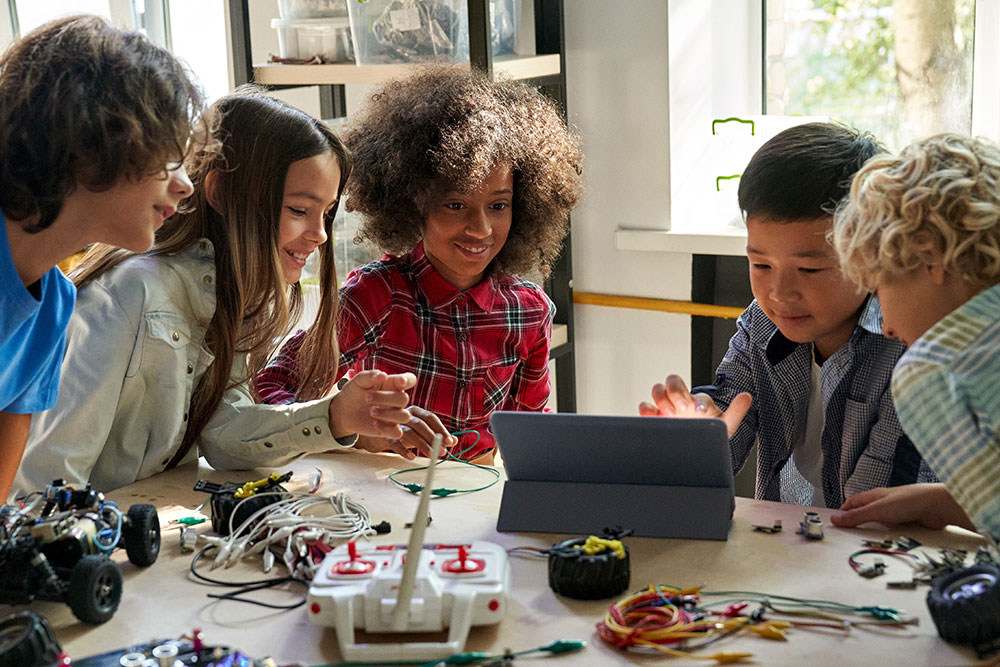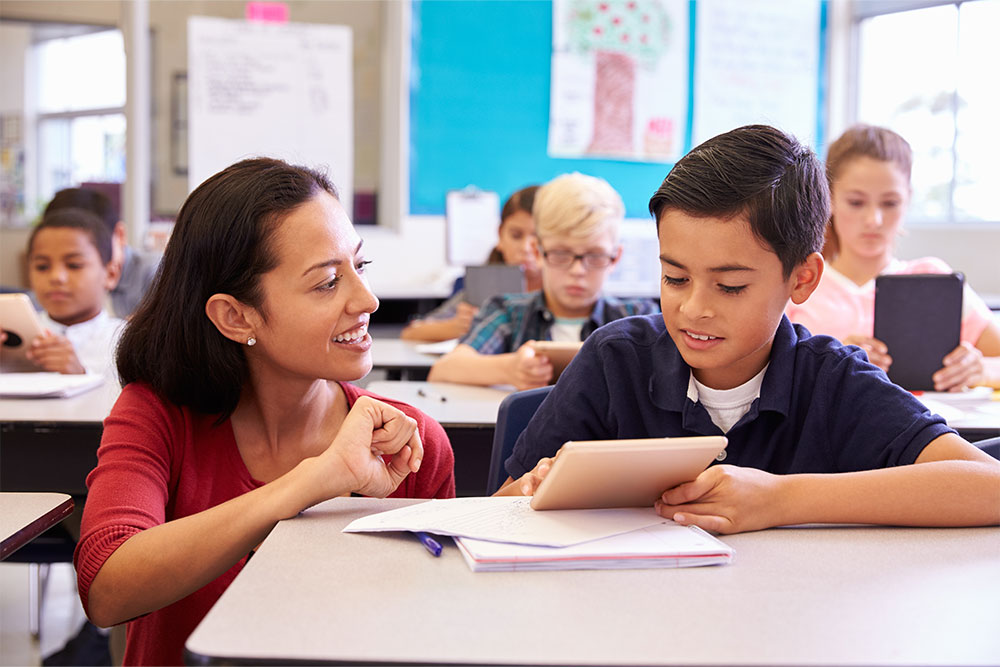
Learning isn’t passive.
Great teachers know education is a two-way street. You can’t treat children like empty vessels waiting to be filled with knowledge. They need to buy into the lesson. They need to be challenged. They need to discuss ideas. (But never while you’re talking.)
And they need to have a good relationship with their teachers.
That’s why effective communication in the classroom is vital.
Read our guide to learn what you can do to develop communication in your classroom and how it can build relationships, save time and help children learn.
Why Communication in the Classroom is Essential
Developing classroom communication is vital to help children learn. And your communication skills can help you develop an ideal learning environment in several ways. We’ve outlined just a few of them here.
Promotes Learning
Your classroom should be noisy (at the correct times). Because children need opportunities to discuss ideas. Children internalise concepts and ideas more easily after talking them through.
More confident pupils can also help guide less confident learners through tricky problems, developing both children’s understanding.
Creates Opportunities for Feedback
Listening to children discuss learning also lets you know how the lesson’s going. You can monitor children’s discussions and pick up on the sticking points or misconceptions holding pupils back.
Depending on what you hear, you know to address children individually or bring the whole class back to explain again.
Improves Relationships
It’s a truism that children don’t make significant progress with teachers they don’t like. Sometimes, you must talk to children outside the traditional teacher/pupil framework and build a different relationship.
Ask questions about their lives and really listen to the answers. Aiming for one daily non-academic interaction with every pupil is good practice. If your timetable doesn’t allow this, make it happen at least once a week. Not only will you get to know and appreciate your pupils better, but they’ll also see that you care for them and should respond to you much more positively.
Saves Time
Excellent teaching sometimes comes down to good time management. Routines are essential in classrooms as children are likelier to meet expectations if they’re easy to follow. So communicate your non-negotiable expectations clearly and keep repeating them.
How to Communicate Effectively in the Classroom
Most teachers have natural communication skills. But it doesn’t mean you can’t learn a few new strategies to help you realise the benefits outlined above.
After all, teaching is a high-pressure situation. You’ve got to hold the attention of 30-odd children, clearly explain activities and give personalised feedback. And almost always in less time than you thought you’d have because the deputy headteacher just had to do an extra long assembly on today of all days. (I might just be speaking from personal experience.)
That’s why good teachers practise. They drill routines, strategies and phrases into their (and their pupils) heads until they become second nature. It saves time and lessens the cognitive load when you’re teaching, giving you that extra precious brain power to figure out how to get little Timmy out from under his desk to work on his maths. (Again, personal experience).
Apply these effective communication strategies in the classroom and you’ll have a much easier time teaching and getting children making progress. (Easier than expected, not easy compared to most other jobs.)
1) Build Relationships
As mentioned, children don’t learn from teachers they don’t like. Particularly vulnerable children who might’ve struggled at school in the past. They likely already have a negative view of school and those cruel adults who keep them there for six hours daily. If you’ve got pupils like this, you must build a relationship.
Take opportunities to talk to the child about non-school related things. Ask about hobbies, interests – anything that the child enjoys. And make sure you’re ready at the start of every lesson to cheerily greet children as they enter the classroom. Let every child know you’re happy to see them. And do this every day, no matter what happened in the last lesson.
And this strategy isn’t just for more challenging pupils. Every child will benefit from a kind greeting or a little one-on-one time with their teacher. Build up goodwill with every child; gradually, you should see a change in how they respond to you and your instructions.
2) Develop Routines
Every second counts in the classroom. And there are predictable things you’ll say and do every day (stop talking and focus on your work, line up for assembly, etc.), so why waste those extra moments repeating the whole phrase or every step of the instruction?
Take some time early in the school year to establish clear expectations and routines. Explain to children exactly what you want in plain language, then slowly take words away. After some time, you could get what used to be a multi-step instruction down to one or two terms.
For example, let’s go back to lining up for assembly. Say to a class of children, “Line up;” after about 10 minutes of squabbling, you’ll probably be left with a clump of children in the shape of anything other than a line. So start by breaking down your instructions – make it clear where the line should start, end and the order you want. After practising a few times, shorten your words until, eventually, you can command a neat, efficient queue to form with one utterance of the word ‘line.’
3) Talk Less
This isn’t about the economy of language like in the previous example. This strategy is all about giving children opportunities to talk.
As a general rule of thumb, it’s recommended children should talk more than you. John Hattie, lauded educational researcher, recommends this approach.
Consider making these tactics commonplace in your classroom:
- Give children a moment to think after you’ve posed a question
- Don’t just repeat and correct something a child says if it’s wrong – allow them to reflect on and improve what they’ve said
- Use think, pair, share – ask a question and then let children discuss answers or ideas with their talk partners before sharing with the class
- Promote genuine class discussions – don’t just go back and forth between you and the class; encourage other pupils to jump in and challenge or build on what children have said
4) Promote Collaboration
Think, pair and share is just one example of positive collaboration in the classroom. Promoting teamwork and on-topic talking amongst children has been shown to help children learn. It can be implemented in the classroom at no extra cost.

Think about your seating plan and try and find good combinations of pupils that will work well together. But make sure you mix up the arrangements from time to time so all children get opportunities to work together. This helps children develop their own communication skills and helps promote collaboration among everyone.
You can also consider peer tutoring. Place more confident learners with those who might be a little behind and you’ll often find they start making progress. Just be sure that the less confident learners aren’t just copying. And also give the more confident children regular opportunities to work with pupils at a similar level.
5) Offer Immediate Feedback
Feedback is critical for children to make progress. And the sooner it’s delivered, the better.
People often have an image of teachers working late into the night, ploughing through a stack of exercise books to mark. And this is absolutely accurate (sorry).
But you must work just as hard during lesson time too. Make sure you’re moving around the room constantly, scanning for the children who haven’t quite got it yet. A quick verbal intervention is more impactful than a whole page of written feedback delivered days after the task.
These verbal interventions are also easier to deliver in a collaborative classroom. While children are talking together, you should listen to their conversations to check their understanding.
6) Use Visuals
Your words should generally be supported by some visual representation. And there are three reasons for this:
- Pictures or videos are great hooks to engage learners or fire up imaginations. Many excellent stories have been inspired by a short film or esoteric image
- Pictograms, graphs or tables are all helpful for explaining complicated concepts or information
- Recording information on the board (or flipchart) eases the cognitive load of children, particularly younger learners; writing something down that the children can refer to later makes it easier for them to focus on the essential skills or concepts you teach
Think About Body Language
Communication isn’t just talking. You’ve got to think about non-verbal communication when you’re teaching too.
A good teacher can project confidence and warmth into a classroom without saying a word. You want to own the room while making children feel safe. And there are a few strategies you can use to do this without speaking a word, such as:
- Smile – It’s obvious, but keep smiling as much as possible. You want children to feel like you’re happy to be there. You might worry about lacking an air of authority if you’re always smiling but think about this: having a reputation as a smiley type makes it all the more impactful when your expression changes and you need to get serious
- Keep your body language open – This is all about projecting subtle confidence. Stand up straight and avoid crossing your arms or ‘hiding’ behind things. You’re the master of your classroom and you want to look like you are
- Get small at the right time – It might seem counterintuitive to the last point, but sometimes, being smaller communicates the most tremendous confidence. If a child is acting out, get to their level (or even lower if your knees can take it) to talk to them. It stops your interaction from becoming a public spectacle that distracts others from learning and subtly lets the distressed child know you’re in control. It shows you’re not panicking or worried and will work with them to find a healthy way forward

How You Can Develop Your Communication Skills
There are more than seven strategies for effective communication. And as a teacher, you need communication skills beyond the classroom. You must build rapport with parents and carers, establish meaningful working relationships and listen with empathy to make the most significant difference in your pupils’ lives.
Our online Communication Skills Training helps you do all this and more. You’ll learn how to identify barriers to communication, use body language effectively and actively listen – all crucial skills for a working teacher. And since the course is entirely online, you can learn when you want. So you don’t have to sacrifice any of your teaching planning time.



















































































































































































































































































































































































































































































































































































































































































































































